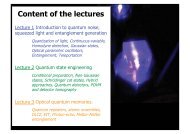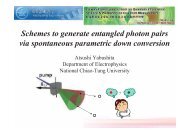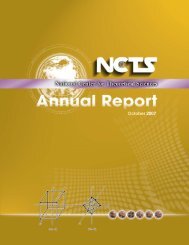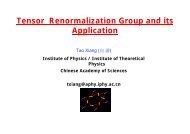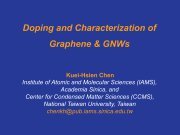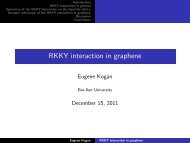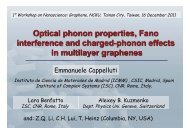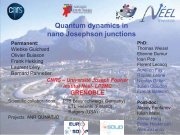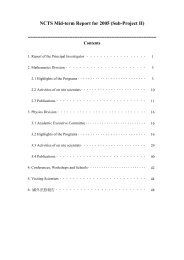Quantum Computing with Polar Molecules
Quantum Computing with Polar Molecules
Quantum Computing with Polar Molecules
Create successful ePaper yourself
Turn your PDF publications into a flip-book with our unique Google optimized e-Paper software.
<strong>Quantum</strong> <strong>Computing</strong><strong>with</strong><strong>Polar</strong> <strong>Molecules</strong>Sabre KaisDepartment of Chemistry and PhysicsPurdue University and QEERI, Qatar
Talk overview• Introduction• <strong>Polar</strong> molecules in optical lattice• Entanglement in optical traps• Alignment-mediated mediated entanglement• Dynamics of entanglement• <strong>Quantum</strong> gates• Applications
<strong>Quantum</strong> Computationti| 000InputOutput| 001| 010|011|100<strong>Quantum</strong>|101Processor|110|111F(| 000)F(|001)F(|010)F(|011)F(|100)F(|101)F(|110)F(|111)Preparing stateProcessing stateDetecting state| in| out U | in| out
DeVincenzo Criteria (2001)A scalable physical system <strong>with</strong> wellcharacterized qubitsThe ability to initialize the state of thequbitsLong decoherence time relative to thegate operation timeUniversal set of quantum gatesQubit-specific measurement capabilityProspects for <strong>Quantum</strong> <strong>Computing</strong>David P. DiVincenzoIBM TJ Watson Research Center, USA
Possible Systems<strong>Quantum</strong> two-level systems:Electron Spin | >,| >Nuclear Spin |+>,|-> |<strong>Polar</strong>ized Photon |L>,|R>Trapped Ion |L0>, |L1><strong>Quantum</strong> Dot |g>,|e>|
System Q op n op= -1Nuclear Spin 10 2 – 10 8 10 -3 – 10 -6 10 5 – 10 14Electron spin 10 -3 10 -7 10 4Ion Trap (In + ) 10 -1 10 -14 10 13Electron – Au 10 -8 10 -14 10 6Electron – GaAs 10 -10 10 -13 10 3<strong>Quantum</strong> dot 10 -6 10 -9 10 3Optical cavity 10 -5 10 -14 10 9Microwave cavity 10 0 10 -4 10 4Crude estimates for decoherence times Q (seconds), operation times op(seconds), and maximum number of operations n op = -1 = Q / op for variouscandidate physical realizations of interacting systems of quantum bits.
What we need for<strong>Quantum</strong> ComputationLow decoherenceAlmost isolated systemStrong controlStrongly coupled to userCh ll i i lChallange: to gain strong, precise control over quantum systemsthat maintain their quantum nature.
<strong>Quantum</strong> Computation <strong>with</strong> Cold <strong>Polar</strong><strong>Molecules</strong> in an Optical LatticeE-field due to dipole of its neighborsE +V (~3kV)| |10Optical latticeTrap depth ~ 100 K| 0 |1-VKCs polar molecule l (~10 4 total t qubits, canperform 10 5 CNOT, <strong>with</strong> decoherence ~5s)Trap of length ~5 mmD. DeMille, PRL 88, 067901 (2002))
Features of the Proposed dApproach• Long decoherence time ~ 1 s or longer.• Easy to scale up the number of quantumgates.• Easy to address individual qubit due tointroduced E‐field gradient.• Involved challenging hll technologies butachievablehttp://qist.lanl.gov the quantum computation roadmap
EntanglementTrapped <strong>Molecules</strong> Proposal for QCArrays of trapped ultracold polar molecules. Spin-less (S=0) polar moleculesin their electronic-vibrational ground-state, <strong>with</strong> zero-projection (M=0) ofthe total angular momentum on the internuclear axis.Qubits correspond to dipole moments up or down relative to the applied E-field.A strong external field <strong>with</strong> appreciable gradient is imposed in order to preventquenching of the dipole moments by rotation and to distinguish among thequbit sites.Molecular dipoles undergo pendular oscillations, which markedly affect thequbit states and the dipole– dipole interaction.
Objectives• Evaluate entanglement of the pendular qubit states for two lineardipoles, characterized by pairwise concurrence, as a function of:(A) Molecular dipole moment rotational constant(B) Strengths of the external field(C) Dipole–dipole p coupling(D) TemperatureExtend the calculations to N‐dipoles• Evaluate the parameters needed for quantum gates• Examine dynamics and decoherence of qubits
Optical LatticeAn optical lattice is formed dby the interference ofcounter‐propagating laser beams, creating aspatially periodic polarization pattern.
Hamiltonian for a Single MoleculeHˆ2P Vtrap(r)2m2BJ Kinetic Trapping Rotation Electricenergy potential al energy fieldε AssumeSeparableRotational state H SH ˆ 2 με S BJ - cosEigenfunctions : Pendular statesε μ
AB Brief fHistory of fPendular StatestDirected States of <strong>Molecules</strong>:Stationary quantum mechanical states for diatomic molecules whose geometricalaxis is preferentially aligned in space, the molecular axis is directed (Generalizedcoherent states, minimal uncertainty states)S. Kais and R.D. Levine, J. Phys. Chem. 91, 5461 (1987)Pendular States of <strong>Molecules</strong>:Directional hybrids , comprised of linear combinations of the field‐free rotor states|J,M> <strong>with</strong> a range of J values but the same fixed value of the M quantum numberSpatial orientation of molecules in strong electric fields andevidence for pendular statesB Fi dih d DR H hb h Ltt t N t 353 412 (1991)B. Friedrich and D.R. Herschbach, Letters to Nature 353,412 (1991)Experimental demonstration for the diatomic molecule iodine monochloride , ICl
Simulating pendular oscillation of oriented moleculesDudley Herschbach and Bretislav Friedrich (Harvard)and doubtful youngsterTaken by S. Kais, 1991
Pendular States QubitsFor the simplest case of a diatomic molecule, the qubiteigenstates resulting from the Stark effect are linear combinationsof Spherical Harmonics, <strong>with</strong> coefficients that depend markedlyon the field strength.There are three dimensionless variables:/BThe ratio of the Stark energy (magnitude of permanent dipole moment timeselectric field strength) to the rotational constant (proportional to inverse ofmolecular moment of inertia)./B <strong>with</strong> = 2 /r 3The square of the permanent dipole moment divided ided bythe cube of the separation distance.k B T/BThe ratio of thermal energy (Boltzmann constant times Kelvin temperature)to the rotational constant
Dipole-Dipole Interaction i i j jR ijVi,jd d i3R ijj(1 3cos2)coscosij
Multi-dipole HamiltonianHˆHˆSHˆddN N1NiH Si1 i1 ji1Vi,jd dForˆH SN2, we expand theW Hˆin the basis ofW0 0 00 W 0W10 0 0 0 W 1W000 0 0 W 1W 1 0000 ,01 ,10and11Hˆd dC 0C0C0CC C0C CX XX X2C2 0CXC0C1CXCXCXC1 (1 3cos)3C C0C C C1C0C1CXX XX R , CXCXCXC1C1CXC1C 1 Where C0X10 cos0 C 0 cos1 C 1cos1
Energy levels, W, for apolar diatomic molecule inan electric field. States arelabeled by yquantumnumbers J, MJ denotes total angularmomentum M projectionon direction of electricfield Qubit states |0>and |1> are in red.Green is the transitionenergy.Pendular Eigenergies~J 1, M ~J0,M00
Angular distributions of the pendular qubitsUnimodalBimodal
Quantify EntanglementEntanglement of FormationWe calculate l the entanglement tof formation,which characterizes the amount of entanglement needed in order toprepare a state described dby a density matrixConcurrence is the simply expression of Entanglement
Pairwise Concurrences
Ui Using a basis of Blltt Bell states:
Superposition p Basis Set• The new basis s set is defined ed as• The new basis set arrangementDan Elliott and Yong Chen (EE and Physics, Purdue)Investigate t superpostion of ultracoldldLiRb molecules
Concurrence v.s. μ/B & ΩrenceConcur• The ground stateentanglement=1 decreases when=2=4μ/B increases.=6=8• The ground stateentanglementincreased as thecoupling constantΩ increases1.0 g0.80.60.40.20.00 2 4 6 8/B(α=90 O )
Concurrence v.s. α & μ/BConcu urrence0.30.20.10.00 20 40 60 80Angle/B=0/B=1/B=2/B=4/B=6/B=8• There is a magic angle(54.74 degrees) whereno entanglement exists.• Before the magic angle,the entanglementdecreases. Beyond that,the entanglementincreases.• Similar to the previousone, the entanglementdecreases when theexternal electric fieldsincreases (Ω=1)
Concurrence v.s. α & ΩConcurr rence0.6 =1=2=4=6=80.40.20.00 10 20 30 40 50 60 70 80 90Angle• The entanglementstays at almost zerobefore the magicangle. While thatincreases fastbeyond the magicangle.• When Ω becomeslarge, the increase ofthe entanglementbecomes faster.(μ/B=4)
Thermal Entanglement
Thermal Pairwise Concurrence
C 120.6N=2N=30.4N=4N=5N=6N=70.2 N=8/B = 1kT/B C 120.50.40.30.20.1N=2N=3N=4N=5N=6N=7N=8/B = 1kT/B C 120.00 1 2 3 4 50.4N=2N=303 0.3 N=4N=5N=60.2 N=7N=80.1/B = 1kT/B 0.00 1 2 3 4 5C 120.00 1 2 3 4 50.3N=2N=3N=40.2 N=5N=6N=7N=80.1/B = 1kT/B 0.00 1 2 3 4 5
C 1C 120.020= 0.1N = 20.015 kT= 10 -4 N = 3N = 4N = 52N = 60.010010N = 70.0050.0000 2 4 /B6 80.0012= 0.10.0008 kT= 0.60.0004N = 2N = 3N = 4N = 5N = 6N = 70.00000 2 4 6 8/BC 10.006N = 2N = 3N = 40.004N = 52N = 6N = 70.002= 0.1kT= kT0.4 040.0000 2 4 6 8/B
Dynamics of Entanglement of <strong>Polar</strong><strong>Molecules</strong> in Pendular States• <strong>Quantum</strong> Liouville equation
ObjectiveInvestigate the dynamics of entanglementof the dipoles system under different initialconditions: external electric field, dipoledipolecoupling constant and the anglebetween external field and the dipole chain.
Experimental parametersExternal field : ~ a few kV cmTrap temperatures μK Space ofopticallattice r λ 2 and ~kBTB~ 105100.31m6 Ground B 104SrO : μ 8.9 D, B 0.33 cm4When B 10 , C12~-1, λ 1 μm B ~10Potential candidate molecules: KCs, CsI, SrO, …5105The key aspect is that although entanglementneeds to be large for some quantum computingalgorithms,it need not be appreciable or evenpresent in the ground eigenstate of the system;it can be induced dynamically during operationof the computer
The Simulation Procedure• Five different initial iti conditions:• Relationship between concurrence & external electricfields (μ/B)– we set Ω=5 5 & α=90 O• Concurrence verses coupling constant (Ω)– The other coefficients are μ/B=3 & α=90 O• Concurrence verses Angle (α)– The other coefficients are μ/B=3 & Ω =3
Units• H is the Hamiltonian <strong>with</strong> the unitless parametersμ/B and Ω/B. The rotational tti constant tB is dealt asthe basic unit in the Hamiltonian.The time scale for the Liouville equation is• Each time step is equal to t=1 t1 ‐‐> > 16ps
Relationship between Concurrence& μ/B; Ω=1E‐5 & α=90 oThe initial state is |003x10-6/B=00/B=1/B=2/B=3/B=4Concurrenc ce210 2x10 -61x10 -6 00 1 2 3 4 5Time
Concurre ence/B=0The initial condition is 1/2 (+/B=11.0 /B=2/B=3/B=405 0.5Conc currenceThe initial condition is 1/2 (+ 15 1.51.0/B=0/B=1/B=22/B=3/B=40.500 0.00 2 4 6 8 100 1 2TimeTime
CNOT Gate
Gates:ClassicalInformation is encoded in a series of bits,and these bits are manipulated via Booleanlogic gates arranged in succession toproduce an end result.<strong>Quantum</strong>Manipulates qubits by executing a series ofquantum gates, each a unitarytransformation acting on a single qubit orpair of qubits. The qubits can then bemeasured, <strong>with</strong> this measurement servingas the final computational ti result.
Matrix representation of simplequantum logic gates0| >= 1> : 111| > = 0> : 00A general unitary transformation is a 2x2 matrix:“NOT” gateU cos( / 2)sin( / 2)sin( / 2) cos( / 2) U| 1|0xNOT0101 1010
<strong>Quantum</strong> Gates
Controlled-NOT Gate 2 1Energy|1 | 1|1 | 0 2 1 2 2 2-pulse at1 1 2|0 |1| 0 | 0 1 2E-field offE-field on 1 2| 0| 0|0| 0| 0|1 | 0|1|1| 0|1|1|1 |1|1|0
CNOT Gate Gt for Pendular Statest
Eti Estimation of Characteristic ti Vl ValuesEext ( x) [ E0 x(Ex)]ˆ,z Ea Eext( xa) Eint( xa)dbx xEint3baa bResonant frequency d E / ~a0 eff ahResonant frequency difference per lattice site ~250kHz23 d eff / 4( / 2) ~ 3kHzCNOT Gate time0 ~ (2)1 50s3.5-6.0 GHz for E ext =2-5 kV/cmFor a microwave pulse, required field strength ~ 10 mV/cm
Generate Bell state0000 , 200 01,00 111 2 22 , 2 00 10,00 113 4 22
Frequency ShiftSrO:μ8.9D, B0.33cm-1, λ 1 μm B~105Bμε B Δω BC 121.001.012.191061.201061.001.10102.331061.17171063.003.035.521063.571073.003.30305.51511063.3434107Δω ~20 60kHz
Experimental ResolutionΔω ~ 20 60kHzLine widths for rotational transition: Ultracold molecules trapped in optical latticeNo data have been reported on line widths for rotationaltransitions of ultracold molecules trapped in an opticallattice and subject to an external electric field Ordinary ygas phase conditions: ~ a few 100 kHz
ConclusionsFor quantum computing, a crucial issue is whether ω islarge enough hto enable the ω 2 transition to be reliablydistinguished from ω 3 (and, equivalently, ω 1 from ω 4). Fortypical candidate polar molecules, this requires resolvingtransitions separated by only tens of kHz. That would not befeasible in conventional molecular spectroscopy. Underordinary ygas phase conditions, transitions betweenmolecular rotational or pendular states have line widths ofthe order of a few 100 kHz.At present, no data have been reported on line widths for rotationalp , ptransitions of ultracold molecules trapped in an optical lattice andsubject to an external electric field
Introduction ti of MTOCT• Multi-target optimal control theory– The tool for calculating laser pulse guiding thequantum system to the selected objective state– Transfer an arbitrary number of k initial states intok target state simultaneously by just one laser fieldKorff, B. M. R.; Troppmann, U.; Kompa, K. L. & de Vivie-Riedle, R., Journal of Chemical Physics, 2005, 123, 244509Tesch, C. M. and de Vivie-Riedle,R. , Physical Review Letters, 2002,89, 157901
Research hObjectiveImplement laser pulses to realize differentquantum logic gates(such as NOT, Hadamard and CNOT)on system of linear trapped polar molecules
System• Two polar molecules trapped in the electric field atlow temperature (μK)• The polar molecule candidate in the simulation isSrO– Permanent dipole moment of 8.9 Debye– Rotational constant B=0.33 cm -1– The optical lattice wavelength of SrO λ=1μm and thespace between them is λ/2.
Strategies t to increase Δω• Place two dipoles into different externalelectric fields– 1 st dipole: 2 nd dipole:– External electric field strength: ~120-180 kV/cm• Short the distance between two dipoles– The distance in the simulation is 0.05 μm , whichis 10% of their length at optical lattice.Wei, Q.; Kais, S.; Chen, Y. P.Journal of Chemical Physics, 2010, 132, 121104.Murphy, B.; Hau, L. V.Physical Review Letters, 2009, 102, 033003.
Relations between dipole‐dipole p interaction;external electric field and frequency shiftDegenerateSplitSplitFurtherOriginalStateIntroduce dipole-dipole couplingFurther introduceexternal electricfield
System Hamiltoniani
• The target function:MTOCT– 1 st term of RHS: Overlap of the initial wave functions drivenby laser field, <strong>with</strong> the target .– 2 nd term: Controls the intensity of the laser– 3 rd term: Ensures Time-dependent Schrödinger Equation isfulfilled for all time steps.
The Laser Pulse
Numerical Approach to Obtain theOptimized Laser Pulse• Rapid convergent iteration i approach developedd•by the Rabitz in 1998Zhu, W. S.; Botina, J.; Rabitz, H.Journal of Chemical Physics 1998, 108, 1953-1963.
Numerical Approach Continued• Illusion of the iteration approach:Initial GuessedPulseUpdated laser pulse based onUpdated laser pulse based onthe evolution of ψ i (t)
Coefficients to check convergence• The average transition probabilitybilit• The fidelity
• The coupling constant Ω/B=0.010 01• The frequency shift Δω=1.6910 -3 cm -1• The time duration of the laser pulse should be10 /Δω, which is 32 ns for this case.• The self evolution of the SrO system is about 29 psper circle.• In the simulation, the basic time step at 0.25ps andthe total length of the pulse is 32 ns. The maxiterations are set at 300.Bomble, L.; Pellegrini, P.; Ghesquiere, P.; Desouter-Lecomte, M.Physical Review A2010, 82,062323
Simulation Result
The Pulse for Realizing CNOT Gate1.50.8Laser Realized CNOT Gate(t) / kV/c cm10 1.00.50.0-0.5Populatio on0.60.40.200011011-1.0-1.50 1x10 4 2x10 4 3x10 4Time (ps)0.00 1x10 4 2x10 4 3x10 4Time (fs)
NOT gates for Molecule l 1 and 2
The Pulse for NOT Gate for Dipole 11.50.8Laser Realized NOT Gate for Dipole 110 1.00.6( (t) / kV/cm0.50.0-0.5Populatioon0.40.200011011-1.0-1.50 1x10 4 2x10 4 3x10 4Time (ps)0.00 1x10 4 2x10 4 3x10 4Time (fs)
The Pulse for NOT Gate for Dipole 21.50.8Laser Realized NOTGate for Dipole 2(t) / kV/ /cm1.00.50.0-0.5Populatio on0.60.4000110110.2-1.0-1.50 1x10 4 2x10 4 3x10 40.00 1x10 4 2x10 4 3x10 4Time (ps)Time (fs)
Hd Hadamard dgate for both moleculesl
The Pulse for Hadamard Gate for Dipole 11.51.0Laser Realized Hadamard Gate for Dipole 1(t) / kV V/cm1.00.50.0-0.5Populati ion0.80.60.400011011-1.00.2-1.5 150 0.01x10 4 2x10 4 3x10 40 1x10 4 2x10 4 3x10 4Time (ps)Time (fs)
The Pulse for Hadamard Gate for Dipole 21.51.0Laser Realized Hadamard Gate for Dipole 2(t) / kV/cm1.00.50.0-0.5Pop pulation0.80.60.400011011-1.0 1002 0.2-1.50 1x10 4 2x10 4 3x10 4Time (ps)0.00 1x10 4 2x10 4 3x10 40 1x10 2x10 3x10Time (fs)
Conclusion• Applied the MTOCT theory to obtain theoptimized laser pulse to quantum logic gates,such as CNOT, NOT and Hadamdard gates,<strong>with</strong> high h fidelity• After reducing the distance to 10% of that inthe optical lattice, the energy shift becomes51MHz and can be resolved by the laser <strong>with</strong>the duration time of 32μsμ
New Directions
Symmetric Top <strong>Molecules</strong>NHCH F CH CF CH 3 3 3 33zCNProperty :IxIyIzx
Hamiltonian of Single MoleculeHˆHˆRHˆSHˆTεˆ 2 Ĵ ( )Ĵ2RB A BzHˆH S μ εμεcosRotationalStarkε μHˆT2p2mVtrapTrapping(assumeconstant)
Rotational & StarkRotational energy :TotalER( J,K) BJ ( J 1) ( A B)rotationalangular momentum :J 0,1,2,3,4, .....Projection of J along molecular axis : K 0, 1, 2, ....., JK2CH 3FStarkenergy :E(J,K,M) με MKJ(J1)SJεJProjection ofJalong external field :M J 0,1, 2, ....., JEffective dipole moment:μeffESε μMJKJ ( J1)
Symmetric Top <strong>Molecules</strong>lQubits:|0> = |J,K,M> = |1,1,+1>|1> = |J,K,M> = |1,1,‐1>1J=0,1,2,… 012 K=0,1, K01 2, ...J=0, 1 K=0 for K≠0J= 1 K=0 for K=0
Energy levels l W and effective dipole moments eff fora symmetric top molecule in an electric fieldK = quantum number denoting projection of J on thesymmetry axis of the moleculeNote that, in contrast to the diatomic case, here the qubitstates split apart linearly as field increases; allows use lowfield strength to increase greatly, giving access toregion where entanglement is large
Symmetric Top• Initial Hamiltonian• Simplified Hamiltonian• NMR Hamiltonian:
ConclusionsSymmetric top molecules, l <strong>with</strong>first-order Stark effect, offer a meansto obtain / ~ 1 and hence largeconcurrence.In the region / < or ~ 1 the maxconcurrence occurs for temperaturesso low that only ground state concurrencematters much.
ENTANGLEMENT CREATION IN COLDMOLECULAR GASES USING STRONGLASER PULSESFelipe Herrera, Birgitta Whaley and Sabre KaisPurdue - Harvard Berkeley PurdueNew Journal of Physics (submitted, 2013)
Entanglement of cold molecules<strong>with</strong> off‐resonant laser pulsesRotational structure in off-resonant optical fieldsRigid RotorLight-induced potential
<strong>Molecules</strong> l in far-detuned d laser fields• Semiclassical pictureStrong off-resonant laser fieldInstantaneous dipole momentLight-matter interaction
<strong>Molecules</strong> l in far-detuned d laser fields• Rotational structureField-dressed rotational spectrumLight-matter HamiltonianLaser intensity parameterQubit statesEigenstates have definite parityQubit transition energy decreases exponentially <strong>with</strong> intensity
Alignment-mediated t d entanglementt• Two-molecule evolution in a strong pulseGaussian pulseBipartite concurrenceInteraction timeInitially separablestates<strong>Molecules</strong> remain entangled after the pulse isover
Entanglement in optical traps• Binary correlations in double well latticesOrientation operatorOrientation correlation measurements
Violation of Bell's inequalities <strong>with</strong> polar moleculesViolation of Bell s inequalities <strong>with</strong> polar moleculesin optical lattices
Entanglement in optical traps• Bell inequality for orientation correlationsInequality violationson the picosecondtimescale
Phonon-induced decoherenceence• Local qubit decoherence• External field fluctuations (classical noise)• Spontaneous emission (quantum noise)• Nonlocal decoherence• Phonon-modulated intermolecular coupling
Phonon-induced decoherenceence• Phonon-modulated excitation hopping• Motion in trap modulates dipole-dipole energy• Optical trapping laser has intensity and frequency noise• Optical lattice phonons can influence system dynamicsSpin-boson modelsystem environment interaction
Summary1) Strong laser pulses can mediate long rangeentanglement in dipolar molecular gases2) Arbitrary degree of entanglement can be preparedby tuning laser pulse parameters3) Entangled states are robust against motionaldecoherence in optical lattices
J=2• rigid rotorIdentifying gQubitsH=BJ J2• adding spin‐rotationcoupling (S=1/2)H = B J 2 + J·S"D" "D 5/2 "J=2"D 3/2 "j=3/2j=5/2J=1J=0"P""S"J=1"P 3/2 ""P 1/2 ""S 1/2 "j=1/2J=0 j=1/2j=3/2spin-rotationsplittingcharge qubitspin qubit
Supersymmetry in <strong>Molecules</strong>
Advances in the field of ultracold atomic andmolecular gases give us the capability to engineer awide range of quantum systemsThe possibilities are almost limitless, <strong>with</strong> real‐timecontrol over features such as lattice structure, density,temperature, level of impurities and disorder,quantum statistics, spin, dimensionality, andinteractions by changing the symmetry, strength,and range.
References• Molecular alignment and orientation• Friedrich & Hershbach, PRL 74, 4623 (1995)• Seideman & Hamilton, Adv. At. Mol. Phys. 52, 289 (2005)• Dipole-dipole interaction in external fields• Herrera & Krems, PRA 84, 051401(R) (2011)• Lemeshko & Friedrich, Mol. Phys. 110, 1873 (2012)• Carr, DeMille, Krems, Ye, New J. Phys. 11, 055049 (2009)• Entanglement t creation and detectionti• S. Kais, Adv. Chem. Phys. 134, 493 (2007).• Amico, Fazio, Osterloh, Vedral, Rev. Mod. Phys 80, 517 (2008)
Cold moleculesles• Applications include:• Cold chemistry and controlled collisions• Dipolar effects ects in quantum gases• <strong>Quantum</strong> simulation of condensed matter• Precision measurements• <strong>Quantum</strong> information processing
Research GroupFinite Size Scalingand<strong>Quantum</strong> Criticality<strong>Quantum</strong> <strong>Computing</strong>and<strong>Quantum</strong> InformationTheoryRoss Hoehn (CHEM)Edwin Antillon (PHYS)Xu Qing (PHYS)Jing Zhu (PHYS)Shuhao-Yeh (CHEM)Yting Zhang (PHYS)Anmer Daskin (CS)Shuxian Jiang (CS)Yudong Cao (ME)Rishabh Chandra (ME)Cyrus Vandrevala (PHYS)Felipe Herrera (CHEM)
http://web.ics.purdue.edu/~kais/qc/
Internal Advisory Committee:Phase I TeamExternal Advisory CommitteeQIQCCCIDirector(Sabre Kais)NSF CCI Program Officer(s)CCI Innovation PartnersAlan Aspuru-GuzikPeter LoveKen BrownDaniel LidarBill BayleySeth Lloyd Joseph Traub Brigitta Whaley David Mazziotti Greg Engel Garnet Chan(25+?)Graduate/Undergraduate Students and Postdoctoral Fellows





